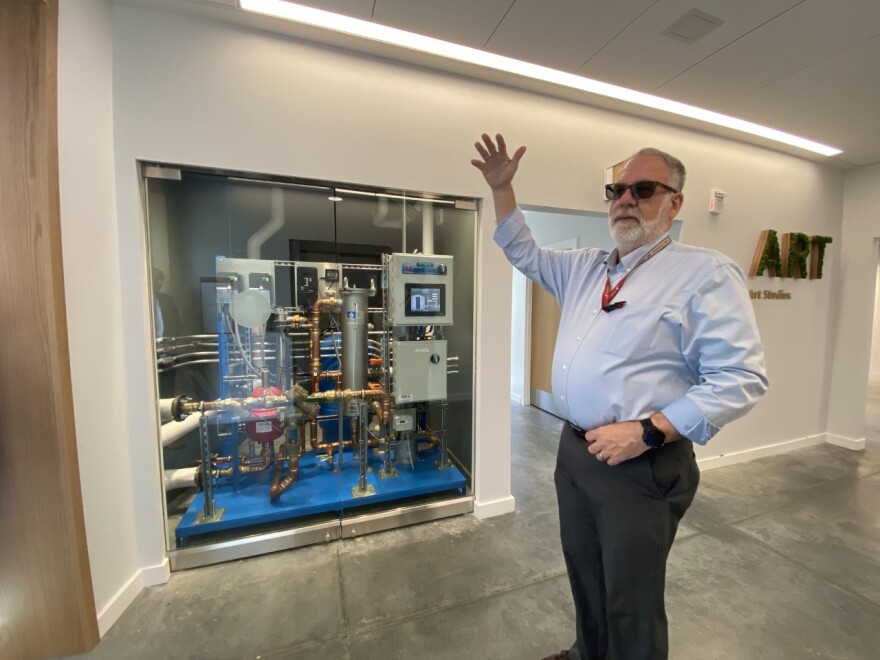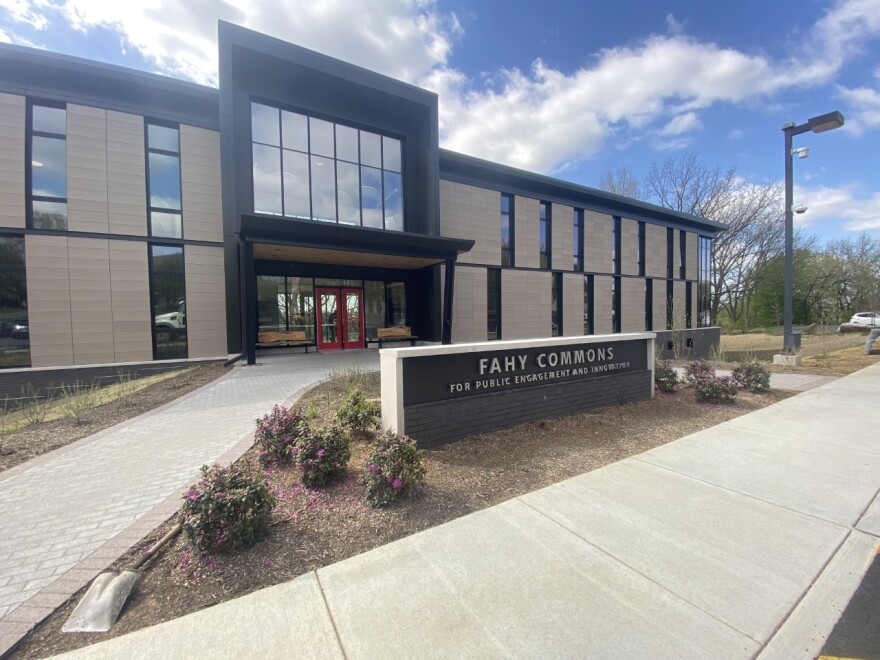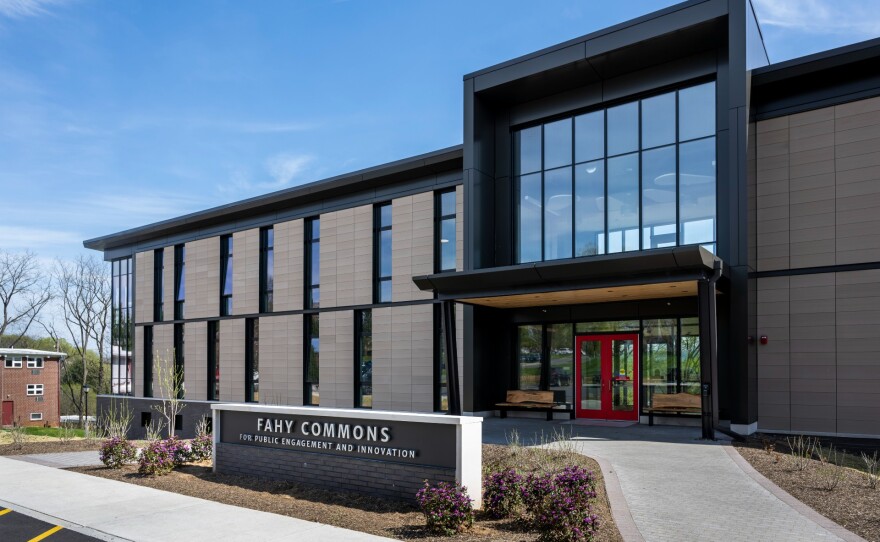ALLENTOWN, Pa. — Walking through the open, light-filled halls of Muhlenberg College’s newest building feels like being outside — and that’s part of the point.
- The first new building on Muhlenberg’s campus in more than a decade, the Fahy Commons for Public Engagement and Innovation, 2400 W. Chew St. opened to students in January
- The 20,000-square-foot, three-floor building cost $13.2 million and sits on land that once held a fraternity house.
- It has more than 180 solar panels and a 10,000-gallon rainwater cistern.
“In a nutshell, it’s trying to make us feel like we're outdoors when we’re indoors,” said Richard Waligora, the college’s capital projects manager. “We're in the trees, we're seeing nature, we're seeing beautiful flowers growing — all the things like that.
“That's the whole intent and that's why you see a lot of tile, a lot of wood in earth tones. It's all trying to blend that together to give you a really warm, natural feeling.”
The first new building on Muhlenberg’s campus in more than a decade, the Fahy Commons for Public Engagement and Innovation, 2400 W. Chew St., opened to students in January. The 20,000-square-foot, three-floor building cost $13.2 million and sits on land that once held a fraternity house. With more than 180 solar panels and a 10,000-gallon rainwater cistern, it’s also one of the first buildings in the world expected to achieve a rigorous sustainability certification for buildings that give more than they take.
I got a tour of @Muhlenberg’s Fahy Commons this morning! Officials are having a grand opening of the sustainable building next week. pic.twitter.com/KMfH2xS8lE
— Molly Bilinski, artisanal sentence crafter (@MollyBilinski) April 19, 2023
“It's all for the intent of having the college students learn about sustainability — making all the green and sustainable stuff transparent, so we can all learn from that,” said Scott Kelly, an architect and sustainability consultant with Re:Vision Architecture, the firm that designed the building.
Construction on the building was funded through a donation. In 2020, Gerald P. Fahy, a 1979 Muhlenberg graduate, and his wife, Cathleen, donated $7.5 million to the college — the largest personal gift in the institution’s history.
“The principles that guided the Fahy Commons’ design align perfectly with our interdisciplinary approach to the liberal arts: inspire creativity and teach design; contribute to student, faculty, staff and community attraction and retention; build connections with others and social interaction; design a space that is flexible and adaptable; and promote physical and mental wellbeing,” said Muhlenberg President Kathleen Harring during a September open house.
In addition to holding the schools of graduate and continuing studies, the building also houses the office of community engagement, art studio spaces, the Muhlenberg Institute of Public Opinion and the Innovation & Entrepreneurship Program.
‘The birds and the bees building’
In addition to the solar panels, which offset about 70% of the building’s electricity’s usage, and the rainwater cistern, used for flushing the building’s nine toilets after a filtration process, Fahy was designed with preservation in mind.
The triple-paned windows are dotted — smaller ones with a film, while the larger ones are acid-etched.
“The intent is to stop birds from crashing into the window, and it's pretty successful,” Waligora said. “We lose about a million birds a day in the U.S. alone.”
“We lose about a million birds a day in the U.S. alone.”Richard Waligora, capital projects manager at Muhlenberg College
A March 7 study published in the journal Frontiers in Ecology and the Environment places estimated bird-window mortalities across the country much higher, at 1 billion annually.
The building can become a visual teaching tool for Daniel Klem Jr., a Muhlenberg biology professor who has researched bird-window collision deaths and possible solutions.
“As the human population and the dwellings in which we live and work increase, windows may contribute to significant declines in select species and the persistent and increasing losses may affect bird populations in general,” Klem argued in one report. “Window-kills are a serious problem to a growing number of people who experience remorse, guilt and anxiety when they discover, or are made aware, that the glass in their homes, workplaces and the commercial buildings they frequent are unintentionally killing the birds they enjoy or appreciate as part of their environment.”
Bee bricks were also placed outside the building, creating homes for the native insects.
“They’re pollinators that are solitary, so they have a place to go,” Waligora said. “So, our architects like to call this the birds and the bees building because they're so funny.”
There are features integrated for human use as well, including high-efficiency lighting, heating and cooling systems, outdoor classroom and event spaces, and sustainable options for commuters, including an on-site shower and electric vehicle charging stations.

‘The first building in the world that was audit ready’
Muhlenberg officials evaluated a variety of sustainability programs and certifications during Fahy’s design process, Waligora said.
They decided on two, the Living Building Challenge Core Green Building Certification, through The International Living Future Institute, and LEED Gold certification, through the U.S. Green Building Council. The former focuses on “creating regenerative buildings and products to restore the health and resilience of economies, cultures, and people,” while the latter’s focus is to “save money, improve efficiency, lower carbon emissions and create healthier places for people.”
In order to qualify, officials had to document the entire building process, including materials.
“There's tons of stuff that's been submitted up to and including the materials made for everything, where it came from, what it's made of — everything,” he said. “Drywall, to the roofing, to the windows, to the furniture, everything. All that had to be accounted for.”
The building has to successfully pass an audit to obtain the certification, but officials said they are confident it will.
“We are the first building in the world that was audit-ready,” Waligora said. “Which means if we don't mess it up, we'll be the first building in the world that is the Living Building Challenge Core Certified.”
Grand opening
The building’s grand opening is set for 4 p.m. April 28, part of Muhlenberg’s 175th Anniversary Celebration which runs April 28-30.
Before the event, the college is hosting EcoFest, an Earth Month and Arbor Day festival. There will be more than 30 vendors, food, music and dance performances, as well as a tree planting and nature walk.










